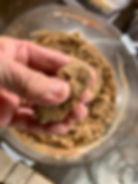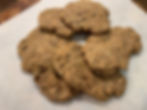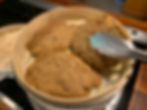Vegan Seitan Lentil 'Steaks' will satisfy that craving
- Cynthia
- Jul 25, 2021
- 5 min read
Updated: Jan 10, 2022
Anybody who's gone WFPB (Whole-Food, Plant-based) will admit there are times when they'll get that craving for a juicy, flavorful cut of, um, 'animal flesh'. In my own case, it's more the memory of those flavors that I wax nostalgic for. There's that distinctive umami thing that we remember about the flavor of meat and can't always get from plants. Or, so we think. It's not true. We can recapture that amazing flavor and texture. It's not even particularly difficult or time-consuming.

I promise you that - in keeping with the name of this website - this is a simple recipe and process. The ingredients are widely available and relatively inexpensive - especially if you shop 'bins' at stores like my local Winco Foods. We're talking pennies per serving for insanely flavorful protein. You can buy the vital wheat gluten and chickpea flour from those wonderful bins. Ditto for the ground flaxseeds, Nutritional Yeast (AKA 'Nooch'), the brown lentils, and the ground onion and garlic powder.

Brushing with a bit of the reserved marinade while grilling will yield this amazing 'meat-like' look, and the flavor will blow you away!
The beauty of this recipe is that, in about 50 minutes, it yields enough for tonight's dinner plus a few more servings for the freezer. And, it would be simple enough to flavor this 'meat' to suit any cuisine: American, Latin, Indian, Asian. Just change up the marinade and what you serve it with.
American inspirations: Make a few of your patties thinner, and slap 'em into a whole wheat burger bun with lettuce, tomato, onion and my vegan oil-free mayonnaise or Buffalo Sauce. Steak salad - sliced on top of a BIG salad. This seitan kills in any 'bowl' ... your choice of grains, veggies or salad. Seitan sliders with grilled onions? Seitan 'skillet' with sweet peppers and onions. Seitan Salisbury Steak, with loads of sautéed mushrooms, gravy and mashed roots (maybe try my Rutabaga Mash?).
Latin inspirations: Fajitas or street tacos, using the thinly sliced 'steak' meat. Add finely shredded cabbage, microgreens, pea shoots, diced or sliced red onions, thinly sliced radishes, diced tomatoes, salsa. Or, go for a 'fattie' ... I mean a burrito.
Indian inspirations: Seitan Vindaloo with a hearty tomato-based curry sauce, tender carrots. As a 'chicken' stand-in for Butter Curry. How about Tikka Masala? Grab those jars of Indian sauces outta the pantry and go for it.
Asian inspirations: Mongolian 'Beef' anyone? Any stir-fry with slices of sweet pepper, onions, grated ginger, garlic and whatever Asian sauce you have in the refrigerator door. What about Seitan Satay on a stick with a peanut sauce? How about seitan steak sliced really thin (best done when it's 'almost' frozen) and tossed to a steaming bowl of Phō or Ramen?
The story of Seitan (the name for wheat gluten products, pronounced "Say-tan") goes way, way back. Centuries, in fact. Back to China and Japan, where it was developed by vegetarian Buddhist monks. Unlike tofu, which 'fools' nobody, seitan has a wonderful way of mimicking meat. It can - like tofu - absorb sauces and flavors, but unlike tofu, it can be convincing to the point of freaking out vegans on occasion. It has a heartiness, and texture - especially when prepared as I have done - that closely resembles the good parts of meat. I mean, you can only eat so many grilled cauliflower 'steaks', right?

Vital wheat gluten is what seitan is made from. Wheat gluten is what remains when wheat flour is mixed with water and repeatedly 'washed' leaving the gluten strands behind. It's higher in protein than tofu, and in fact, is as high in protein as beef - without the fat and cholesterol, animal cruelty, negative impacts on the environment and at a fraction of the cost.
There's been a lot of discussion lately regarding the heavily processed nature of a lot of meat analogues. Seitan is much less processed. And, when you make the meat substitute yourself, you are in control of the sodium and fat that come with many of the additives in heavily advertised, commercial meat analogues.
My recipe 'ups the ante' for whole food meat analogues by adding in nutritious, fiber-filled brown lentils. Oh, and chickpea flour (more fiber and protein) and ground flaxseeds (for the Omega-3's!)
The great texture that this 'meat' analogue provides is courtesy of cooked brown lentils and chopped Shiitaki mushrooms that were in the Instant Pot flavoring the lentils as they cooked. The Instant Pot lentil instructions: 1 cup brown lentils to 3 cups water. Pinch of salt. Toss in the dried Shiitaki mushrooms, if using. Cook using High Pressure for 6 minutes, Natural Release for 15 minutes. Uncover and drain thoroughly in a colander. Pick out the mushrooms - blot them a bit drier - and coarsely dice. Set aside, with the lentils.
Let's take a tour of the process of making Seitan Lentil Steak.

First and foremost - get your stuff out and measured. Ready to rock and roll. This is called Mis en Place.

If you're not using canned lentils, cook some. I make them in the Instant Pot - with the dried Shiitaki caps right in there! Saves a step or two, plus helps to flavor the lentils.

Bring out the food processor. You can also do this by hand, of course. Combine the Vital Wheat Gluten, chickpea flour, ground flaxseeds, onion/garlic powder, mushroom powder (if using), paprika and smoke powder. Pulse a few times to combine.
Now, you can add in the 'wet' ingredients: Tomato paste, soy/tamari/Worcestershire sauce, maple syrup. Pulse several more times to combine.
Finally, add in the cooked diced mushrooms and cooked lentils. Pulse a few times more. Don't utterly obliterate the lentils and mushrooms into a paste. You want to preserve the discernible shapes and texture.

Check the mixture. Take a ball of it and see that it more or less holds together. It really should resemble pie dough.

Turn the mixture out onto a clean work surface and knead. Turn a quarter turn, knead. Wash. Rinse. Repeat. You want a 'spongey' texture that indicates that the gluten is developing.

Cut the dough into roughly equal portions and flatten each with your hands or a rolling pin. Shape each into about a half-inch thick 'steak' shape. Whatever that means to you.

Time to get all steamy. I love this two level, Thodd&Go bamboo steamer that I got from Amazon. It has silicone, non-stick liners that make cleanup easy.
Steam the steaks for 25 minutes, turning once about halfway through so they 'cook' evenly.

Pull 'em off the steam and let the steaks cool a bit. Now, you can marinate them or freeze them. I keep a couple out for marinating and freeze the rest - wrapped lightly in parchment paper and in a zip-lock freezer bag.

Marinate the steaks at least 30 minutes. Or, until dinnertime. Feel free to play with marinades here. If you're headed south of the border, for instance, consider a green sauce, cumin, a bit more smoke powder, lime juice. Asian? Use soy sauce, saké, Vietnamese garlic/chili paste, a bit of honey or date syrup, and a splash of water.

For the meal shown above, I went 'old school' with sautéed greens, sliced steaks with a chili sauce, grilled planks of steamed yam, and corn on the cob - dressed with Cholula Sauce (my favorite!).

Serve steak strips over sautéed vegetables. Toss in some pasta and chopped fresh tomatoes just at the end.
BTW: you might have some lentils leftover from cooking them. I did. But, waste not, want not. The very next day, those lentils - about one cup - went into a fast pasta salad for lunch. Dressed in nothing more than Dijon mustard, lemon juice and honey - quickly shaken together for an oil-free vinaigrette. I tossed in cucumber, cherry tomatoes, radicchio and green onions.

This button will take you to PayPal where you can securely pop a bit in the 'tip jar'.
Thanks!



